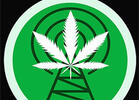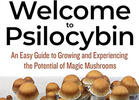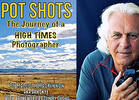It was a great year for counterculture and drug-related books. Here are 12 of them.

• Agents of Chaos: Thomas King Forçade, High Times and the Paranoid End of the '70s
By Sean Howe
High Times finally has a biography. Tom Forçade founded the magazine in 1974, five years after arriving in New York from Arizona as the self-professed king of the underground press. He ran with Abbie Hoffman, Jerry Rubin and the Yippies, then turned his back on them. He believed in revolutionary politics but was so deranged even Hunter S. Thompson said Forcade was too wild for him. Both loved guns, but Forçade hid behind pseudonyms in a clergy outfit so as to remain mysterious and inscrutable. High Times was his one big idea that stuck; everything else like shooting a film about the Sex Pistols' only tour of America pretty much was a bust. But oh what a magazine the staff produced in the '70s while Forçade was smuggling weed and involved in other adventures. He fired the staff once en masse, then hired them right back the next day. Forçade's stamp on the company he started, Trans High Corporation, lived on long past his death by suicide in 1978. Was he a double agent? Howe wonders but can't prove it. It's all part of the paranoid end of the '70s.
• Cannabis Terminology Style Guide
By Oaksterdam University
After reading this definitve guide to cannabis words and terms, you'll never say marijuana or pot again. According to the editors, marijuana is "scientifically inaccurate" and pot is a slang term "almost always used in a deragatory way to refer to cannabis flowers." Weed is not even in the book. There are 92 entries, from adult use to whole plant.
By Catherine Hiller
For her next act after Just Say Yes: A Marijuana Memoir, Hiller returned to the fiction format. Cybil, who's in her 50s and 60s in the story, has an active sex life. For her, affairs with men are the spice of life. We follow Cybil as she bonds with one of her partners, yet continues to look for love elsewhere at the same time. She has no remorse, just experiences. Pot plays a role but it's just part of the adventurous behavior of a really chill MILF.

• Energy Follows Thought: The Stories Behind My Songs
By Willie Nelson
Nelson has songs, lots of them, so many that he wrote a book about them with frequent collaborator David Ritz and harmonica player Mickey Raphael. It's a coffee-table style hardcover with black & white photos throughout its 400 pages. I immedately searched for "Me and Paul" on page 86 in the "Yesterday's Wine" chapter. Lyrics are on he left-hand page and a story about it on the right ("One thing is certain: I never could have made it without Paul by my side"). In the pages on "Where Do You Stand?" we learn it was about Gatewood Galbraith, a hemp activist who several times in the early-'90s ran for the governor of Kentucky, which Nelson supported. Nelson says about the live recording of "Superman" with Snoop Dogg in Amsterdam: "We had so much fun we decided to do it live on The David Letterman Show. We had another blast." However, his other weed song, "Roll Me Up (And Smoke Me) When I Die)," is not included.
• Exile & Ecstasy: Growing Up with Ram Dass and Coming of Age in the Jewish Psychedelic Underground
By Madison Margolin
Margolin has a fascinating backstory. Born in L.A. in a famiy with three mothers, numerous kids and a famous drug-defense attorney father, Bruce, who practises Hinjusim, in recent years she went searching for a more traditional form of Judism that wasn't practised at home. Margolin found it through psychedelics and visits to Israel, where she wrote parts of this 230-page paperback. The Ram Dass part of the story is due to her father's friendship with the former Richard Albert who was tossed out of Harvard along with Timothy Leary for giving students psychedelics in 1963. He's a great role model for Margolin and the muse for her blending of the Jewish and psychedelic worlds.
• Pot Shots: The Journey of a High Times Photographer
By Malcolm MacKinnon
Former High Times editor-in-chief MacKinnon is known for his photography as well as his writing. The main focus of the book is activists and landscapes. Most of the 333 images in this wide-sized paperback, including 39 covers, are creative in spirit. Big fields of hemp plants, Western imagery complemented with sundry cannabis or colorful glass pipes and major players in drug-policy reform like Jack Herer and Tommy Chong light up the pages.

• Seeing Through the Smoke: A Cannabis Specialist Untangles the Truth About Marijuana
By Dr. Peter Grinspoon
Dr. Lester Grinspoon was the foremost expert on cannabis science in America during his many years at Harvard where he wrote the breakthrough book Marihuana Reconsiderd in 1971. Grinspoon passed his considerable knowledge on to his sons. One of them, Peter, is a primary care physician and cannabis specialist at Massachusetts General Hospital and also works at Harvard. This is deep hardcover dive (it's 425 pages) into cannabis science and the politics that have kept cannabis under-researched and under the gun by government officials and naysayers for years. Grinspoon admits to his own addictions in the text that is thick with storylines, from "Reefer Pessimism" to "Blunt Truths" to "Toking and Driving." He tackles weighty subjects while generally stating the obvious: It's a miraculious plant
By Melissa Etheridge
It was a big year for the singer-songwriter from Kansas. In addition to her one-woman Broadway show Melissa Etheridge: My Window, she published a memoir. They work well together, telling the same story, one on stage, the other in print. The main focuses of both are her ambitious drive to become a rock star and the loss of her son to an opioid overdose in 2020. With the help of cannabis, pyschedelics, terrific writing and adoring fans, Etheridge remains at top of her game, and then some.
• The Joy of Cannabis: 75 Ways to Amplify Your Life Through the Science and Magic of Cannabis
By Melanie Abrams and Larry Smith
Best known for his The Six-Word Memoir Project and book series, Smith teamed up with University of California at Berkeley professor and novelist Abrams on this unique 282-page hardover. It's broken down into six sections – Body, Mind, Connection, Producivity, Creativity and Joy – plus a 30-page "toolkit" including history and basics at the beginning and a glossary in the back. The 75 "ways" are spread out through the sections. One suggestion is to "Bake San Francisco Style Sourdough Bread," Another is to roll down a grassy hill. It's a fun book, for both adults and kids.

• The Jive 95: An Oral History of America's Greatest Underground Rock Radio Station KSAN San Francisco
By Hank Rosenfeld
Rock radio was a freeform exercise in transmitting good audio vibes to the burgeoning counterculture in the '60s and '70s. WNEW-FM was our station in New York; KSAN was San Francisco's. Rosenfeld chronicles the station's rise to notoriety that started in '67 and ran though 1980. The main focus is Tom Donahue, a larger than life (literally) programmer who seized the moment as the Bay Area was in the midst of a psychedelic revolution, both musically and via drugs. The author captures the excitement of the era that saw so many great bands – Grateful Dead, Jefferson Airplane, Big Brother & the Holding Company – roll through the station, affectionately known as "The Jive 95."
• Welcome to Psilocybin: An Easy Guide to Growing and Experiencing the Potential of Magic Muhsrooms
By Seth Warner
From Quick American Archives, the publishing company founded by Ed Rosenthal and his wife Jane Klein, comes this tome about fungi. At 170 pages, it's plenty deep with sections on dosing and microdosing (read the excerpt here) and cultivation, drying and storage - "all the tools and instructions needed to successfully grow potent magic mushrooms at home." Famous for his Marijuana Grower's Guide and other books, Rosenthal does the edit and Dennis McKenna provides the intro.
By Steven Blush
The New York journalist known for his love of hardcore and metal documents the schism between rock and disco in the '70s that resulted in the Disco Demoltion Day in 1979 during a doubleheader at Comiskey Park in Chicago. A riot ensured and the second game was canceled; ultimaely disco waned and evolved into house and techno. But it's interesting to read about how rock groups and artists like the Stones, Rod Stewart, Blondie, KISS and even the Graeful Dead all jumped on the disco bandwagon and got down and boogied. Blush basically pins disco's ascent on rock's "lethargic" decline. Punk rockers also rebelled against disco. Still, he says disco “changed music for the better.” More on the book at Medium
Honorable Mentions

• Convictions of a Chef: Cooking for the Counterculture and the One Percent by Evan Marcus-Rotman
• For Country and Cannabis by Al Byrne
• Higher: The Lore, Legends and Legacy of Cannabis by Dan Michaels and Erik Christiansen
• Let's Get Baked: The Official Cannabis Cookbook by Haejin Chun and Jamie Evans
• Ten Trips: The New Reality of Psychedelics by Andy Mitchell
• Weed: Cannabis Culture in the Americas by Kaitlin Donohue
• Weed Witch: The Essential Guide to Cannabis for Magic and Wellness by Sophie Saint Thomas
More 2023 Best-ofs






